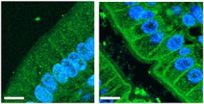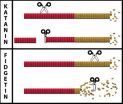(Press-News.org) A new study suggests uric acid may play a role in causing metabolic syndrome, a cluster of risk factors that increases the risk of heart disease and type 2 diabetes.
Uric acid is a normal waste product removed from the body by the kidneys and intestines and released in urine and stool. Elevated levels of uric acid are known to cause gout, an accumulation of the acid in the joints. High levels also are associated with the markers of metabolic syndrome, which is characterized by obesity, high blood pressure, elevated blood sugar and high cholesterol. But it has been unclear whether uric acid itself is causing damage or is simply a byproduct of other processes that lead to dysfunctional metabolism.
Published Aug. 7 in Nature Communications, the new research at Washington University School of Medicine in St. Louis suggests excess uric acid in the blood is no innocent bystander. Rather, it appears to be a culprit in disrupting normal metabolism.
"Uric acid may play a direct, causative role in the development of metabolic syndrome," said first author Brian J. DeBosch, MD, PhD, an instructor in pediatrics. "Our work showed that the gut is an important clearance mechanism for uric acid, opening the door to new potential therapies for preventing or treating type 2 diabetes and metabolic syndrome."
Recent research by the paper's senior author, Kelle H. Moley, MD, the James P. Crane Professor of Obstetrics and Gynecology, and her collaborators has shown that a protein called GLUT9 is an important transporter of uric acid.
DeBosch, a pediatric gastroenterologist who treats patients at St. Louis Children's Hospital, studied mice to learn what happens when GLUT9 stops working in the gut, essentially blocking the body's ability to remove uric acid from the intestine. In this study, the kidney's ability to remove uric acid remained normal.
Eating regular chow, mice missing GLUT9 only in the gut quickly developed elevated uric acid in the blood and urine compared with control mice. And at only 6-8 weeks of age, they developed hallmarks of metabolic syndrome: high blood pressure, elevated cholesterol, high blood insulin and fatty liver deposits, among other symptoms.
The researchers also found that the drug allopurinol, which reduces uric acid production in the body and has long been used to treat gout, improved some, but not all, of the measures of metabolic health. Treatment with the drug lowered blood pressure and total cholesterol levels.
Exposure to uric acid is impossible to avoid because it is a normal byproduct of cell turnover in the body. But there is evidence that diet may contribute to uric acid levels. Many foods contain compounds called purines that break down into uric acid. And adding to growing concerns about fructose in the diet, evidence suggests that fructose metabolism in the liver also drives uric acid production.
"Switching so heavily to fructose in foods over the past 30 years has been devastating," Moley said. "There's a growing feeling that uric acid is a cause, not a consequence, of metabolic syndrome. And now we know fructose directly makes uric acid in the liver. With that in mind, we are doing further research to study what happens to these mice on a high-fructose diet."
INFORMATION:
This work was supported by the Pediatric Scientist Development Program of the National Institutes of Health (NIH), grant 5K12HD000850-27, DDRCC grant P30DK52574, and R01HD040390-07; the German Ministry of Education and Research; and the State of Brandenburg. The Washington University Mouse Diabetes Model Phenotyping Core is supported by DRTC grant P60 DK020579. Mass spectrometry was performed in the Metabolomics Facility at Washington University (P30 DK020579).
DeBosch BJ, Kluth O, Fujiwara H, Schurmann A, Moley KH. Early-onset metabolic syndrome in mice lacking the intestinal uric acid transporter SLC2A9. Nature Communications. Aug. 7, 2014.
Washington University School of Medicine's 2,100 employed and volunteer faculty physicians also are the medical staff of Barnes-Jewish and St. Louis Children's hospitals. The School of Medicine is one of the leading medical research, teaching and patient-care institutions in the nation, currently ranked sixth in the nation by U.S. News & World Report. Through its affiliations with Barnes-Jewish and St. Louis Children's hospitals, the School of Medicine is linked to BJC HealthCare.
New culprit identified in metabolic syndrome
2014-08-08
ELSE PRESS RELEASES FROM THIS DATE:
Musical training offsets some academic achievement gaps, research says
2014-08-08
WASHINGTON -- Learning to play a musical instrument or to sing can help disadvantaged children strengthen their reading and language skills, according to research presented at the American Psychological Association's 122nd Annual Convention.
The findings, which involved hundreds of kids participating in musical training programs in Chicago and Los Angeles public schools, highlight the role learning music can have on the brains of youth in impoverished areas, according to presenter Nina Kraus, PhD, a neurobiologist at Northwestern University.
"Research has shown that ...
Disney Research leads development of tool to design inflatable characters and structures
2014-08-08
The air pressure that makes inflatable parade floats, foil balloons and even inflatable buildings easy to deploy and cost effective can be challenging to designers of those same inflatables due to limitations in today's fabrication process, but a new interactive computational tool enables even non-experts to create intricate inflatable structures.
Developed by a team from Disney Research Zurich, ETH Zurich and Columbia University, the method reverse-engineers the physics of inflation as the designer sketches the shape of the structure and the placement of seams. As a ...
Disney Research process designs tops and yo-yos with stable spins despite asymmetric shapes
2014-08-08
Tops and yo-yos are among the oldest types of playthings but researchers at Disney Research Zurich and ETH Zurich have given them a new spin with an algorithm that makes it easier to design these toys so that they have asymmetric shapes.
The algorithm can take a 3D model of an object and, within less than a minute, calculate how mass can be distributed within the object to enable a stable spin around a desired axis. Sometimes, adding voids within the object is sufficient to provide stability; in other cases, the object's shape might need to be altered a bit or a heavier ...
Disney Researchers develop 'feel effect' vocabulary to tell stories with sense of touch
2014-08-08
Sound effects and visual effects have long been standard tools for entertaining audiences, but even as storytellers increasingly turn to haptic feedback to engage the sense of touch in games, theme park rides and movies, they have lacked a common vocabulary to describe or access these "feel effects." Researchers at Disney Research Pittsburgh are beginning to fill that gap.
In a study to be presented at the ACM Symposium on Applied Perception, Aug. 8-9, in Vancouver, Canada, Disney researchers worked with human participants and a Carnegie Mellon University psychologist ...
Disney Researchers develop method to capture stylized hair for 3D-printed figurines
2014-08-08
Perhaps no aspect of 3D printing has captured the popular imagination more than personalized figurines with the facial features of real people. Now, researchers at Disney Research Zurich and the University of Zaragoza have developed a method that can incorporate an individual's hairstyle as well.
The researchers will present their new method at ACM SIGGRAPH 2014, the International Conference on Computer Graphics and Interactive Techniques in Vancouver, Aug. 10-14.
Miniature statues with a person's likeness are nowadays produced by scanning the individual's face with ...
Do women and men ride differently?
2014-08-08
For centuries, horse riding was largely restricted to males. The previous situation is in stark contrast to the present day, when nearly 80 percent of riders are women. Modern-day equestrian sports are unique in that men and women compete directly against one another at all levels, from beginners in gymkhanas to national champions in the Olympic Games. "For this reason it is interesting to consider whether a theory of riding that was developed exclusively for men can be applied to women," explains Natascha Ille, the first author of the recent publication.
A rider is ...
The immediate aftermath of an oil spill
2014-08-08
The immediate aftermath of an oil spill
The fate of oil during the first day after an accidental oil spill is still poorly understood, with researchers often arriving on the scene only after several days. New findings from a field experiment carried out in the North Sea provide valuable insight that could help shape the emergency response in the immediate wake of disasters.
It is well known that oil and water don't mix. Less well known is the fact that when petroleum is spilt onto a water surface, a fraction of the oil immediately begins to evaporate into the air or ...
Wiggly microRNA binding implies a more complex genome regulation
2014-08-08
(PHILDELPHIA) – MicroRNAs (miRNAs) regulate protein-coding gene abundance levels by interacting with the 3´ end of various messenger RNAs. Each target site matches the first few nucleotides of the targeting miRNA, the so called "seed" region, and this interaction leads to the degradation of the target or prevents its translation into amino acids. This dogma has led researchers to largely look for perfect base-pair matching of the "seed" region among candidate targets.
New research published today (August 8th) in Nature's open access journal Scientific Reports suggests ...
Scientists unravel mystery of brain cell growth
2014-08-08
In the developing brain, special proteins that act like molecular tugboats push or pull on growing nerve cells, or neurons, helping them navigate to their assigned places amidst the brain's wiring.
How a single protein can exert both a push and a pull force to nudge a neuron in the desired direction is a longstanding mystery that has now been solved by scientists from Dana-Farber Cancer Institute and collaborators in Europe and China.
Jia-huai Wang, PhD, who led the work at Dana-Farber and Peking University in Beijing, is a corresponding author of a report published ...
Microtubule-based strategies for promoting nerve regeneration after injury
2014-08-08
After injury, damaged axons have the capacity to regenerate, but the regenerative capacity of the axon, particularly axons of the central nervous system, is quite limited. This is because the damaged axons tend to retract, because they encounter obstacles such as scar tissue and inhibitory molecules, and because their growth rates simply do not match those of a juvenile axon. Prof. Peter W. Baas from Drexel University, USA focus on microtubules as among the most important factors in encouraging injured adult axons to regenerate. Microtubules are hollow polymeric filaments ...



